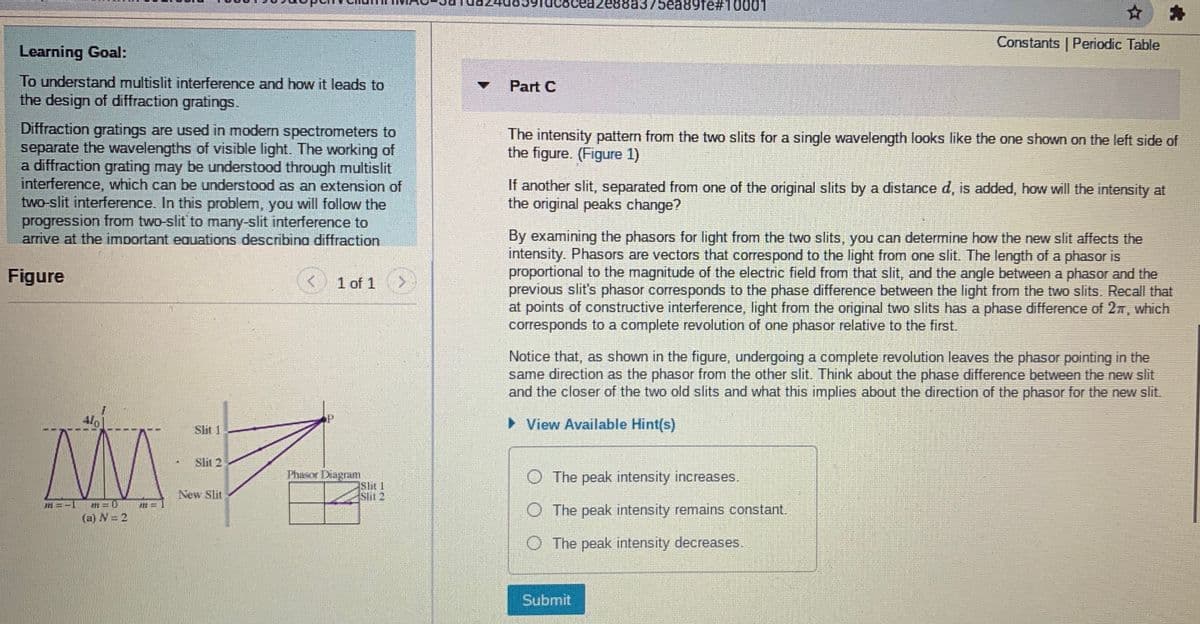The intensity pattern from the two slits for a single wavelength looks like the one shown on the left side of the figure. (Figure 1) If another slit, separated from one of the original slits by a distance d, is added, how will the intensity at the original peaks change? By examining the phasors for light from the two slits, you can determine how the new slit affects the intensity. Phasors are vectors that correspond to the light from one slit. The length of a phasor is proportional to the magnitude of the electric field from that slit, and the angle between a phasor and the previous slit's phasor corresponds to the phase difference between the light from the two slits. Recall that at points of constructive interference, light from the original two slits has a phase difference of 2n, which corresponds to a complete revolution of one phasor relative to the first. Notice that, as shown in the figure, undergoing a complete revolution leaves the phasor pointing in the same direction as the phasor from the other slit. Think about the phase difference between the new slit and the closer of the two old slits and what this implies about the direction of the phasor for the new slit. • View Available Hint(s)
The intensity pattern from the two slits for a single wavelength looks like the one shown on the left side of the figure. (Figure 1) If another slit, separated from one of the original slits by a distance d, is added, how will the intensity at the original peaks change? By examining the phasors for light from the two slits, you can determine how the new slit affects the intensity. Phasors are vectors that correspond to the light from one slit. The length of a phasor is proportional to the magnitude of the electric field from that slit, and the angle between a phasor and the previous slit's phasor corresponds to the phase difference between the light from the two slits. Recall that at points of constructive interference, light from the original two slits has a phase difference of 2n, which corresponds to a complete revolution of one phasor relative to the first. Notice that, as shown in the figure, undergoing a complete revolution leaves the phasor pointing in the same direction as the phasor from the other slit. Think about the phase difference between the new slit and the closer of the two old slits and what this implies about the direction of the phasor for the new slit. • View Available Hint(s)
Chapter9: Optics
Section: Chapter Questions
Problem 7Q
Related questions
Question
100%

Transcribed Image Text:Ba375ea89fe#10001
Constants | Periodic Table
Learning Goal:
To understand multislit interference and how it leads to
Part C
the design of diffraction gratings.
Diffraction gratings are used in modern spectrometers to
separate the wavelengths of visible light. The working of
a diffraction grating may be understood through multislit
interference, which can be understood as an extension of
two-slit interference. In this problem, you will follow the
progression from two-slit to many-slit interference to
arrive at the important equations describina diffraction
The intensity pattern from the two slits for a single wavelength looks like the one shown on the left side of
the figure. (Figure 1)
If another slit, separated from one of the original slits by a distance d, is added, how will the intensity at
the original peaks change?
By examining the phasors for light from the two slits, you can determine hơw the new slit affects the
intensity. Phasors are vectors that correspond to the light from one slit. The length of a phasor is
proportional to the magnitude of the electric field from that slit, and the angle between a phasor and the
previous slit's phasor corresponds to the phase difference between the light from the two slits. Recall that
at points of constructive interference, light from the original two slits has a phase difference of 2, which
corresponds to a complete revolution of one phasor relative to the first.
Figure
< 1 of 1
Notice that, as shown in the figure, undergoing a complete revolution leaves the phasor pointing in the
same direction as the phasor from the other slit. Think about the phase difference between the new slit
and the closer of the two old slits and what this implies about the direction of the phasor for the new slit.
410
> View Available Hint(s)
Slit 1
Slit 2
Phasor Diagram
Slit 1
Slit 2
The peak intensity increases.
New Slit
The peak intensity remains constant.
(a) N= 2
O The peak intensity decreases.
Submit
Expert Solution
Step 1
Required :
How does the intensity change when another slit is added.
Trending now
This is a popular solution!
Step by step
Solved in 2 steps

Knowledge Booster
Learn more about
Need a deep-dive on the concept behind this application? Look no further. Learn more about this topic, physics and related others by exploring similar questions and additional content below.Recommended textbooks for you


University Physics Volume 3
Physics
ISBN:
9781938168185
Author:
William Moebs, Jeff Sanny
Publisher:
OpenStax

Glencoe Physics: Principles and Problems, Student…
Physics
ISBN:
9780078807213
Author:
Paul W. Zitzewitz
Publisher:
Glencoe/McGraw-Hill


University Physics Volume 3
Physics
ISBN:
9781938168185
Author:
William Moebs, Jeff Sanny
Publisher:
OpenStax

Glencoe Physics: Principles and Problems, Student…
Physics
ISBN:
9780078807213
Author:
Paul W. Zitzewitz
Publisher:
Glencoe/McGraw-Hill


Physics for Scientists and Engineers, Technology …
Physics
ISBN:
9781305116399
Author:
Raymond A. Serway, John W. Jewett
Publisher:
Cengage Learning

College Physics
Physics
ISBN:
9781285737027
Author:
Raymond A. Serway, Chris Vuille
Publisher:
Cengage Learning